CANM Artist in Residence captures windows to the past
CANYONS OF THE ANCIENTS NATIONAL MONUMENT — The Artist-in-Residence Program at Canyons of the Ancients National Monument, in partnership with the Southwest Colorado Canyons Alliance, connects people with a place that holds the highest density of cultural sites in the country: around 30,000 sites show human habitation spanning 10,000 years.
This is the ancestral home of 26 Associated Tribes and Pueblos. It holds history older than the Pyramids of Giza and preserves structures, and artifacts, of ancient cultures.
On Feb. 10, 2025, Lisa Spangler drove her camper van to Dolores, Colorado, where she would stay for longer than the two-week residency, host not only the promised one, but two public outreach programs, and create a work of art to donate to the CANM Museum & Visitor Center.
“I couldn’t decide on just one thing,” Lisa said about the four works of art she ended up donating. “I could spend a year there … there’s just so much to see and learn and there is no way two weeks is enough!”
Spangler found inspiration in every aspect of the landscape, from plants and mountains to small sherds of pottery. She said after some time at the monument, she started to get a feel for where one could expect to find ancient structures.
But her most unexpected connection to the land were tiny pieces of pottery, called sherds, that are found in and around different sites. For her, it was a piece of history she could touch then return for others to enjoy or for it to eventually return to earth. One of her donated paintings features a sherd she found at Lowry Pueblo.
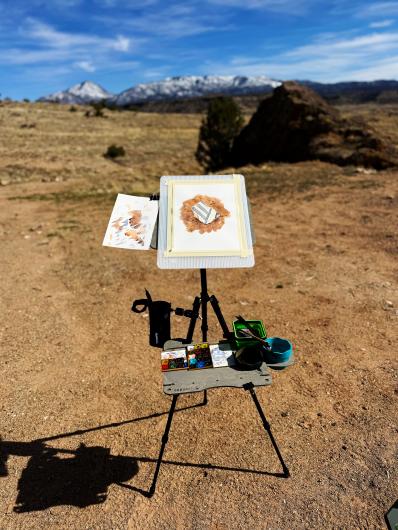
| 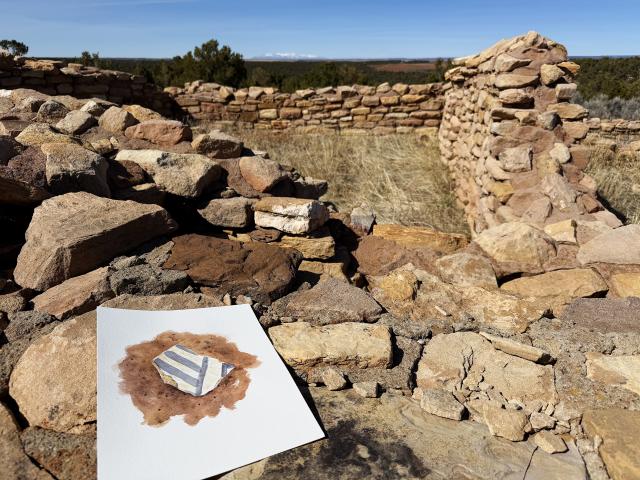
|
Lowry Pueblo is a 1,000-year-old Ancestral Puebloan village named after George Lowry, an early 20th century homesteader. Lowry Pueblo was built on top of the houses of an earlier community around AD 1060 and inhabited for about 165 years. Lowry Pueblo began as a small village with a few rooms and a kiva. Several more rooms, the Great Kiva, and Kiva B were added between AD 1085 and 1170. By the time the last families left and migrated south and east, the pueblo had 40 rooms, eight kivas, and a Great Kiva.
“Finding them out on the landscape … knowing it was made hundreds of years ago is an incredible feeling. You can’t touch the pueblos — you don’t want to accidentally do damage to the site — but the sherds are a piece of history you can hold in your hand,” said Spangler. “I loved learning in the visitor center about the significance of pottery and how they are sometimes broken on purpose for offerings. I created this piece to encourage people to sketch pottery sherds instead of taking them. I wanted to capture that feeling of finding them.”
The small pieces of pottery were fun for her to discover on hikes and while visiting sites. The Antiquities Act of 1906 and the Archeological Resources Protection Act of 1979 make it illegal to excavate, remove, damage, or deface archaeological resources, but Lisa enjoyed taking images and making sketches of those finds for a memory that would last forever.
Spangler and her husband hiked throughout the monument, and everywhere she went she took the time to fill a nature journal. Her sketches included cultural sites, pottery sherds, color studies, trees, and landscapes.

|
“Nature journaling is about documenting your discoveries in nature on paper, with words — like notes, stories or poems — and sketches,” she said. “I made one of my public outreach programs a nature journaling workshop to show people you can make your own residency in a place — you don’t have to be official. Take your journal, go someplace, learn about it, and fill your journal with words and pictures. The time you spend working on your journal will put a place in your heart and memory in a way a quick phone photo won’t.”
Some of her sketches became larger pieces, including the one she donated to the monument of Saddlehorn Pueblo.
“When I first glimpsed Saddlehorn Pueblo my heart soared, and I knew I had to paint it!” she exclaimed. “The colors, the view of Sleeping Ute Mountain, and the smell of the pines and junipers … I just really loved it there.”
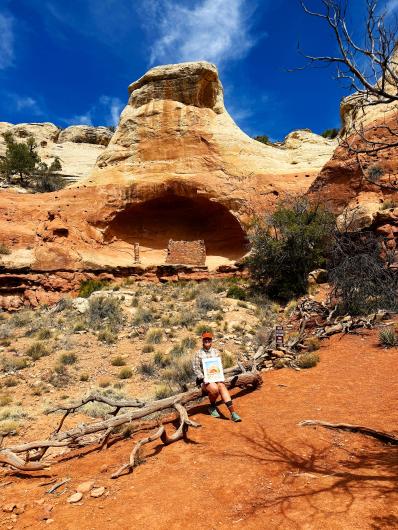
| 
|
Saddlehorn Pueblo is located in a geological feature that looks like a saddle horn. This cliff dwelling has two rooms in the alcove and two structures on a pinnacle approximately 100 feet above the alcove. Tree ring samples from these beams mostly dated to around AD 1228–1232, with one from the AD 1250s. Pottery studies suggest that Saddlehorn Pueblo was likely lived in from around AD 1250 until about AD 1285.
Canyons of the Ancients is located in the Four Corners region of southwestern Colorado and is part of the Trail of the Ancients National Scenic Byway, which includes sites like Mesa Verde National Park 12 miles east of the monument. As part of the National Conservation Lands, the monument offers exceptional opportunities for hunting, solitude, wildlife viewing, fishing, history exploration, scientific research and a wide range of traditional uses.
The BLM manages NLCS public lands for the benefit of current and future generations, as a part of the BLM's multiple-use and sustained yield mission. This means respecting the ties that native and traditional communities have to public lands, as well as being welcoming of diverse interests and uses.
The monument also surrounds and encompasses three of the four sections of Hovenweep National Monument, which is managed by the National Park Service. Spangler ended up dispersed camping throughout those areas.
While she experienced several well-known sites preserved at Canyons of the Ancients, but she did not have time to visit them all. Throughout the monument there is evidence of villages, field houses, check dams, reservoirs, great kivas, cliff dwellings, shrines, sacred springs, agricultural fields, petroglyphs, and sweat lodges. Some areas have more than 100 sites per square mile.
“It is truly a landscape untouched, where you can hopefully go down a dirt road to nowhere and have it all to yourself and be immersed in this landscape,” said Amala Posey-Monk, supervisory park ranger for CANM. “We are a well-kept secret here in the Four Corners and a lot of people didn’t really know we existed.”
Posey-Monk had previously worked with the National Park Service. When she took a new position with Canyons of the Ancients she “was blown away by the exhibits, the hands-on activities and the way that I could learn about the people who have been on this landscape for hundreds and thousands of years … then go out to this amazing landscape that is pretty much untouched. You can see just how it was left 800 years ago, and that is a special thing.”
Over 8,400 of the potential 30,000 sites within the monument have been recorded by archaeologists, and 13 have been stabilized and preserved for visitation, including Painted Hand Pueblo.
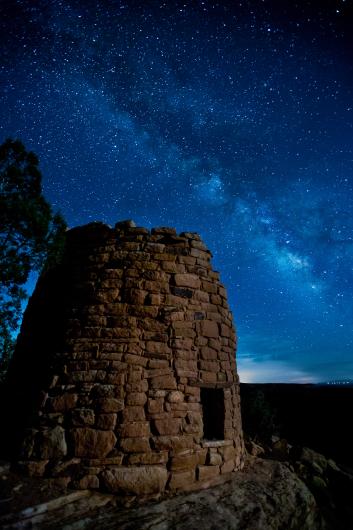
| 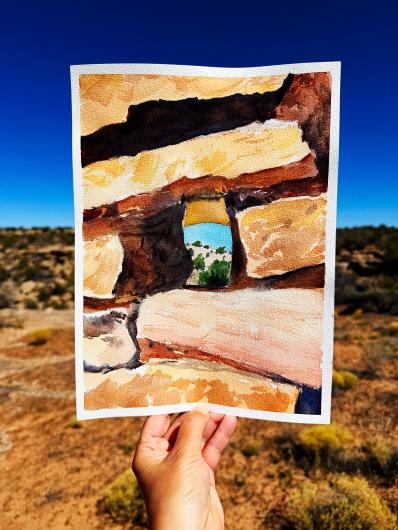
|
Built in the AD 1200s, Painted Hand Pueblo was a small village of about 20 rooms that still include faint rock paintings and petroglyphs. The designs of the ancient images have special meaning to Tribal descendants. In 2014, the Painted Hand Pueblo was placed on the National Register of Historic Places.
“Looking through the windows at Painted Hand Pueblo, you wonder what the view was like when the Ancient Puebloans were here,” Spangler reflected. “One thing that impressed me was no matter where I was, the pueblos always had amazing views of mountains.”
The pueblo has several windows, but she chose one to paint that was smaller and closer to the ground. Spangler had learned about it during her orientation tour but had learned so much during that period she forgot about the window until she donated the completed painting. She was reminded that it was aligned with the sun to mark solstices and equinoxes, and that there are petroglyphs that also show that cycle.
“It made this window to the past even more special,” she said. “I’m so honored to be here in this special place, with sacred mountains all around. The area is so rich with culture and cultural sites, and you feel interconnected.”
Spangler also showed her love for CANM with a Valentine’s Day public outreach program. The visitor center and museum gets around 30,000 visitors every year.
“The start of my residency was perfect timing for Valentine’s Day weekend, and I thought, ‘Everyone can paint a heart,’” she said. “We wrote love letters to the monument.”
Spangler had visitors to the CANM Visitor Center and Museum create painted hearts saying what they loved about CANM. From “walking the footsteps of the people who came before” to “the colors of the land,” there were many reasons the monument was special to people of all ages.

|
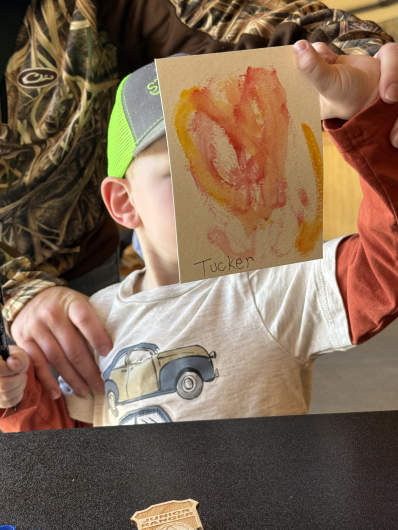
| 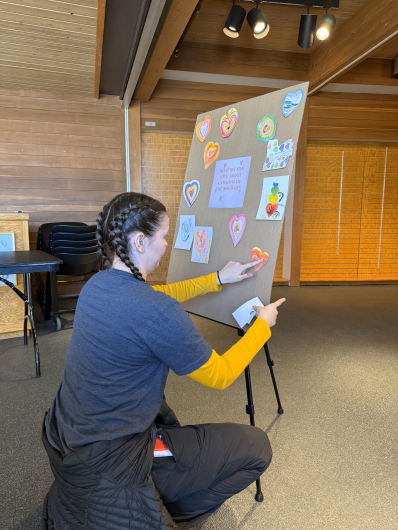
| 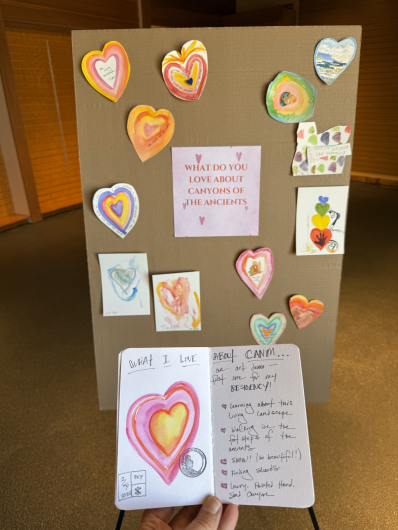
|
“This really, truly, is a special place where we are balancing a variety of different missions. It is a privilege to work here. I want to retire here,” Posey-Monk said. “These artists coming to the monument and helping us tell that story is special because we get to preserve their experience with the living landscape.”
Inhabited by humans, including the Ancestral Puebloans, for at least 10,000 years, this land continues to serve visitors and locals alike as a space for recreation, hunting, livestock grazing, and energy development.
Brigette Waltermire, BLM Colorado public affairs specialist
Related Stories
- BLM Colorado, Grand Junction Field Office host recreation summit
- Growing a Culture of Co-stewardship with Betsy Chapoose of the Ute Indian Tribe
- BLM Colorado hosts biannual Ute Tribal Consultation meeting at Canyons of the Ancients National Monument
- Video: Reimagining restoration in the San Luis Valley
- Secretary Deb Haaland visits with Ancestral Lands Conservation Corps crew working to stabilize Lowry Pueblo
Office
PO Box 151029
Denver Federal Center- Building 40
Lakewood, CO 80215
United States
